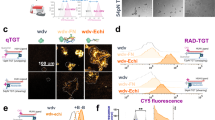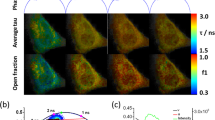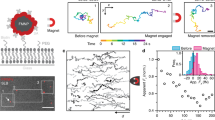Abstract
Cells and organelles are delimited by lipid bilayers in which high deformability is essential to many cell processes, including motility, endocytosis and cell division. Membrane tension is therefore a major regulator of the cell processes that remodel membranes, albeit one that is very hard to measure in vivo. Here we show that a planarizable push–pull fluorescent probe called FliptR (fluorescent lipid tension reporter) can monitor changes in membrane tension by changing its fluorescence lifetime as a function of the twist between its fluorescent groups. The fluorescence lifetime depends linearly on membrane tension within cells, enabling an easy quantification of membrane tension by fluorescence lifetime imaging microscopy. We further show, using model membranes, that this linear dependency between lifetime of the probe and membrane tension relies on a membrane-tension-dependent lipid phase separation. We also provide calibration curves that enable accurate measurement of membrane tension using fluorescence lifetime imaging microscopy.

This is a preview of subscription content, access via your institution
Access options
Access Nature and 54 other Nature Portfolio journals
Get Nature+, our best-value online-access subscription
$29.99 / 30 days
cancel any time
Subscribe to this journal
Receive 12 print issues and online access
$259.00 per year
only $21.58 per issue
Buy this article
- Purchase on Springer Link
- Instant access to full article PDF
Prices may be subject to local taxes which are calculated during checkout





Similar content being viewed by others
References
Helfrich, W. Elastic properties of lipid bilayers: theory and possible experiments. Zur Naturforschung C 28, 693–703 (1973).
Soleimanpour, S. et al. Headgroup engineering in mechanosensitive membrane probes. Chem. Commun. 52, 14450–14453 (2016).
Evans, E., Heinrich, V., Ludwig, F. & Rawicz, W. Dynamic tension spectroscopy and strength of biomembranes. Biophys. J. 85, 2342–2350 (2003).
Rawicz, W., Smith, B. A., McIntosh, T. J., Simon, S. A. & Evans, E. Elasticity, strength, and water permeability of bilayers that contain raft microdomain-forming lipids. Biophys. J. 94, 4725–4736 (2008).
Lieber, A. D., Schweitzer, Y., Kozlov, M. M. & Keren, K. Front-to-rear membrane tension gradient in rapidly moving cells. Biophys. J. 108, 1599–1603 (2015).
Lieber, A. D., Yehudai-Resheff, S., Barnhart, E. L., Theriot, J. A. & Keren, K. Membrane tension in rapidly moving cells is determined by cytoskeletal forces. Curr. Biol. 23, 1409–1417 (2013).
Pontes, B. et al. Membrane tension controls adhesion positioning at the leading edge of cells. J. Cell Biol. 216, 2957–2977 (2017).
Gauthier, N. C., Masters, T. A. & Sheetz, M. P. Mechanical feedback between membrane tension and dynamics. Trends. Cell Biol. 22, 527–535 (2012).
Gauthier, N. C., Fardin, M. A., Roca-Cusachs, P. & Sheetz, M. P. Temporary increase in plasma membrane tension coordinates the activation of exocytosis and contraction during cell spreading. Proc. Natl Acad. Sci. USA 108, 14467–14472 (2011).
Masters, T. A., Pontes, B., Viasnoff, V., Li, Y. & Gauthier, N. C. Plasma membrane tension orchestrates membrane trafficking, cytoskeletal remodeling, and biochemical signaling during phagocytosis. Proc. Natl Acad. Sci. USA 110, 11875–11880 (2013).
Sedzinski, J. et al. Polar actomyosin contractility destabilizes the position of the cytokinetic furrow. Nature 476, 462–466 (2011).
Lafaurie-Janvore, J. et al. ESCRT-III assembly and cytokinetic abscission are induced by tension release in the intercellular bridge. Science 339, 1625–1629 (2013).
Boulant, S., Kural, C., Zeeh, J. C., Ubelmann, F. & Kirchhausen, T. Actin dynamics counteract membrane tension during clathrin-mediated endocytosis. Nat. Cell Biol. 13, 1124–1131 (2011).
Saleem, M. et al. A balance between membrane elasticity and polymerization energy sets the shape of spherical clathrin coats. Nat. Commun. 6, 6249 (2015).
Morlot, S. et al. Membrane shape at the edge of the dynamin helix sets location and duration of the fission reaction. Cell 151, 619–629 (2012).
Wang, Y. et al. Single molecule FRET reveals pore size and opening mechanism of a mechano-sensitive ion channel. eLife 3, e01834 (2014).
Berchtold, D. et al. Plasma membrane stress induces relocalization of Slm proteins and activation of TORC2 to promote sphingolipid synthesis. Nat. Cell Biol. 14, 542–547 (2012).
Sinha, B. et al. Cells respond to mechanical stress by rapid disassembly of caveolae. Cell 144, 402–413 (2011).
Gabella, C. et al. Contact angle at the leading edge controls cell protrusion rate. Curr. Biol. 24, 1126–1132 (2014).
Warshaviak, D. T., Muellner, M. J. & Chachisvilis, M. Effect of membrane tension on the electric field and dipole potential of lipid bilayer membrane. Biochim. Biophys. Acta Biomembranes 1808, 2608–2617 (2011).
Zhang, Y.-L., Frangos, J. A. & Chachisvilis, M. Laurdan fluorescence senses mechanical strain in the lipid bilayer membrane. Biochem. Biophys. Res. Commun. 347, 838–841 (2006).
Templer, R. H., Castle, S. J., Rachael Curran, A., Rumbles, G. & Klug, D. R. Sensing isothermal changes in the lateral pressure in model membranes using di-pyrenyl phosphatidylcholine. Faraday Discuss. 111, 41–53 (1999).
Haidekker, M. A. & Theodorakis, E. A. Ratiometric mechanosensitive fluorescent dyes: design and applications. J. Mat. Chem. C 4, 2707–2718 (2016).
Kuimova, M. K. et al. Imaging intracellular viscosity of a single cell during photoinduced cell death. Nat. Chem. 1, 69–73 (2009).
Vysniauskas, A., Balaz, M., Anderson, H. L. & Kuimova, M. K. Dual mode quantitative imaging of microscopic viscosity using a conjugated porphyrin dimer. Phys. Chem. Chem. Phys. 17, 7548–7554 (2015).
Kulkarni, R. U. & Miller, E. W. Voltage imaging: pitfalls and potential. Biochemistry 56, 5171–5177 (2017).
M’Baye, G., Mély, Y., Duportail, G. & Klymchenko, A. S. Liquid ordered and gel phases of lipid bilayers: fluorescent probes reveal close fluidity but different hydration. Biophys. J. 95, 1217–1225 (2008).
Klymchenko, A. S. Solvatochromic and fluorogenic dyes as environment-sensitive probes: design and biological applications. Acc. Chem. Res. 50, 366–375 (2017).
Su, D., Teoh, C. L., Wang, L., Liu, X. & Chang, Y.-T. Motion-induced change in emission (MICE) for developing fluorescent probes. Chem. Soc. Rev. 46, 4833–4844 (2017).
Sherin, P. S. et al. Visualising the membrane viscosity of porcine eye lens cells using molecular rotors. Chem. Sci. 8, 3523–3528 (2017).
Vyšniauskas, A. et al. Tuning the sensitivity of fluorescent porphyrin dimers to viscosity and temperature. Chem. Eur. J. 23, 11001–11010 (2017).
Fin, A., Vargas Jentzsch, A., Sakai, N. & Matile, S. Oligothiophene amphiphiles as planarizable and polarizable fluorescent membrane probes. Angew. Chem. Int. Ed. 51, 12736–12739 (2012).
Dal Molin, M. et al. Fluorescent flippers for mechanosensitive membrane probes. J. Am. Chem. Soc. 137, 568–571 (2015).
Rawicz, W., Olbrich, K. C., McIntosh, T., Needham, D. & Evans, E. Effect of chain length and unsaturation on elasticity of lipid bilayers. Biophys. J. 79, 328–339 (2000).
Verolet, Q. et al. Twisted push–pull probes with turn-on sulfide donors. Helv. Chim. Acta 100, 11564 (2017).
Neuhaus, F. et al. Correlation of surface pressure and hue of planarizable push–pull chromophores at the air/water interface. Beilstein J. Org. Chem. 13, 1099–1105 (2017).
Sampaio, J. L. et al. Membrane lipidome of an epithelial cell line. Proc. Natl Acad. Sci. USA 108, 1903–1907 (2011).
van Meer, G. & Simons, K. Lipid polarity and sorting in epithelial cells. J. Cell. Biochem. 36, 51–58 (1988).
Pietuch, A., Brückner, B. R. & Janshoff, A. Membrane tension homeostasis of epithelial cells through surface area regulation in response to osmotic stress. Biochim. Biophys. Acta 1833, 712–722 (2013).
Dai, J. W., Sheetz, M. P., Wan, X. D. & Morris, C. E. Membrane tension in swelling and shrinking molluscan neurons. J. Neurosci. 18, 6681–6692 (1998).
Alam Shibly, S. U., Ghatak, C., Sayem Karal, M. A., Moniruzzaman, M. & Yamazaki, M. Experimental estimation of membrane tension induced by osmotic pressure. Biophys. J. 111, 2190–2201 (2016).
Gauthier, N. C., Rossier, O. M., Mathur, A., Hone, J. C. & Sheetz, M. P. Plasma membrane area increases with spread area by exocytosis of a GPI-anchored protein compartment. Mol. Biol. Cell. 20, 3261–3272 (2009).
Ben-Shaul, A. in Molecular Theory of Chain Packing, Elasticity and Lipid–Protein Interaction in Lipid Bilayers (eds Lipowsky, R. & Sackmann, E.) Vol. 1, 359–401 (Elsevier, 1995).
Mackley, M. Stretching polymer chains. Rheol. Acta 49, 443–458 (2010).
Koynova, R. & Caffrey, M. Phases and phase transitions of the phosphatidylcholines. Biochim. Biophys. Acta Rev. Biomembranes 1376, 91–145 (1998).
Ho, J. C. S., Rangamani, P., Liedberg, B. & Parikh, A. N. Mixing water, transducing energy, and shaping membranes: autonomously self-regulating giant vesicles. Langmuir 32, 2151–2163 (2016).
Oglęcka, K., Rangamani, P., Liedberg, B., Kraut, R. S. & Parikh, A. N. Oscillatory phase separation in giant lipid vesicles induced by transmembrane osmotic differentials. eLife 3, e03695 (2014).
Yanagisawa, M., Imai, M. & Taniguchi, T. Shape deformation of ternary vesicles coupled with phase separation. Phys. Rev. Lett. 100, 148102 (2008).
Oglęcka, K., Sanborn, J., Parikh, A. N. & Kraut, R. S. Osmotic gradients induce bio-reminiscent morphological transformations in giant unilamellar vesicles. Front. Physiol. 3, 120 (2012).
Chen, D. & Santore, M. M. Three dimensional (temperature–tension–composition) phase map of mixed DOPC-DPPC vesicles: two solid phases and a fluid phase coexist on three intersecting planes. Biochim. Biophys. Acta 1838, 2788–2797 (2014).
Hamada, T., Kishimoto, Y., Nagasaki, T. & Takagi, M. Lateral phase separation in tense membranes. Soft Matter 7, 9061–9068 (2011).
Petruzielo, R. S., Heberle, F. A., Drazba, P., Katsaras, J. & Feigenson, G. W. Phase behavior and domain size in sphingomyelin-containing lipid bilayers. Biochim. Biophys. Acta 1828, 1302–1313 (2013).
Macchione, M., Chuard, N., Sakai, N. & Matile, S. Planarizable push–pull probes: overtwisted flipper mechanophores. ChemPlusChem 82, 1062–1066 (2017).
Prifti, E. et al. A fluorogenic probe for SNAP-tagged plasma membrane proteins based on the solvatochromic molecule Nile red. ACS Chem. Biol. 9, 606–612 (2014).
Mariana, A., Francesco, R., Martin, H., Christian, E. & Erdinc, S. Laurdan and Di-4-ANEPPDHQ probe different properties of the membrane. J. Phys. D 50, 134004 (2017).
Doval, D. A. et al. Amphiphilic dynamic NDI and PDI probes: imaging microdomains in giant unilamellar vesicles. Org. Biomol. Chem. 10, 6087–6093 (2012).
Riggi, M. et al. A decrease in plasma membrane tension inhibits TORC2 activity via sequestration into PtdIns(4,5)P2-enriched domains. Nat. Cell Biol. https://doi.org/10.1038/s41556-018-105-z (in press).
Wahl, M., Koberling, F., Patting, M. & Erdmann, H. R. Time-resolved confocal fluorescence imaging and spectrocopy system with single molecule sensitivity and sub-micrometer resolution. Curr. Pharmaceut. Biotech. 5, 299–308 (2004).
Acknowledgements
The authors thank V. Mercier, G. Molinard and M. Laporte for technical support and useful scientific discussions. The authors thank the NMR, MS and Bioimaging platforms for services, and the University of Geneva, the Swiss National Centre of Competence in Research (NCCR) Chemical Biology, the NCCR Molecular Systems Engineering and the Swiss NSF for financial support. A.R. acknowledges funding from the Human Frontier Science Program CDA-0061-08, the Swiss National Fund for Research grants nos. 31003A_130520, 31003A_149975 and 31003A_173087, and the European Research Council Starting Grant no. 311536 (2011 call). E.D. acknowledges funding from Human Frontier Science Program (LT00305/2011-L).
Author information
Authors and Affiliations
Contributions
A.C., N.S., S.M. and A.R. designed the project. S.S. and M.D.M. synthesized the FliptR probe. E.D. and M.G.-G. designed and performed initial FLIM measurements. C.T. developed and made vertical PDMS walls for MDCK cell culture. A.C. performed all other experiments and analysis. A.C., E.D., N.S., S.M. and A.R. wrote the paper.
Corresponding author
Ethics declarations
Competing interests
The authors declare no competing interests.
Additional information
Publisher’s note: Springer Nature remains neutral with regard to jurisdictional claims in published maps and institutional affiliations.
Supplementary information
Supplementary Information
Supplementary Methods, Supplementary Figures, and Video Captions
Supplementary Video 1
Staining of cells with FliptR
Supplementary Video 2
Fast-FLIM time-lapse of HELA cells under hyperosmotic shock
Rights and permissions
About this article
Cite this article
Colom, A., Derivery, E., Soleimanpour, S. et al. A fluorescent membrane tension probe. Nature Chem 10, 1118–1125 (2018). https://doi.org/10.1038/s41557-018-0127-3
Received:
Accepted:
Published:
Issue Date:
DOI: https://doi.org/10.1038/s41557-018-0127-3
This article is cited by
-
Mechanical activation opens a lipid-lined pore in OSCA ion channels
Nature (2024)
-
Light-driven biological actuators to probe the rheology of 3D microtissues
Nature Communications (2023)
-
Embryo mechanics cartography: inference of 3D force atlases from fluorescence microscopy
Nature Methods (2023)
-
Directly imaging emergence of phase separation in peroxidized lipid membranes
Communications Chemistry (2023)
-
A molecular mechanosensor for real-time visualization of appressorium membrane tension in Magnaporthe oryzae
Nature Microbiology (2023)



